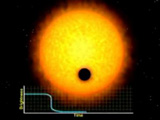Today.Az » Weird / Interesting » More than 100 'Earth-like' planets discovered in past few weeks
23 July 2010 [13:58] - Today.Az
 More than 100 planets that are a similar size to Earth have been discovered in just the past few weeks, it has been announced.
More than 100 planets that are a similar size to Earth have been discovered in just the past few weeks, it has been announced.
The discovery was made by the space telescope Kepler which has been scanning the skies for planets that are orbiting stars since it was launched in January last year. The breakthrough raises the tantalising prospect that we may not be alone in the Universe. Scientists now believe that there are likely to be around 100 million planets in the Milky Way that harbour exactly the right conditions for life.
And they expect to be able to identify around 60 of these habitable Earth-like planets within the next two years. Astronomer Dimitar Sasselov told a conference that a space telescope has uncovered 140 different planets which are around the same size as Earth.
He described the remarkable breakthrough as "fulfilling the dreams of Copernicus".
Kepler finds planets by detecting almost imperceptible 'winks' - the tiny amount of dimming that occurs each time a planet moves across the face of a star. Transits', as they are known, by terrestrial planets produce a small change in a star's brightness of about 100 parts per million, lasting for 2 to 16 hours.
Information such as a planet's size and the extent of its orbit can be calculated from the amount of dimming, the length of time between 'winks' and the star's mass. It will be searching the heavens for day and night without any interruption for the next 4 years, Sasselhov said.
Sasselov unveiled Kepler’s discoveries at the TEDGlobal conference in Oxford last week. Guest speakers at TED are given just 18 minutes each to outline their "big idea".
He said: "Life is a chemical system that really needs a smaller planet, water and rocks and lots of complex chemistry to originate emerge and survive. Sasselov said: ‘There is a lot more work we need to do with this but the statistical result is loud and clear and it is that planets like our own Earth are out there."
"Our own Milky Way galaxy is rich in thee kinds of planets."
For the next stage of the mission the team will study all of the candidate planets and try and discern which of them have the right conditions for life.
"This is great news because with our own little telescope, just in the next two years we’ll be able to identify 60 of them," he said.
Sasselov said that over the past 15 years almost 500 planets have been found around other stars in the galaxy but, until now, few of these had been considered Earth-like. "Science is in the process of redefining life as we know it," he said.
/Daily Mail/
|
|